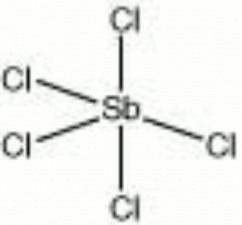Antimony pentachloride
Description
A yellow, oily liquid with a putrid smell. Antimony pentachloride is used as a Stain for materials containing hydroxyl groups such as Dammar, Mastic, sterols, nondrying oils, and vitamins. It reacts to form an adduct that fluoresces blue-white in Ultraviolet light. Antimony pentachloride is moisture sensitive and will decompose in the presence of Water or alcohols.
Synonyms and Related Terms
APC; antimony perchloride
Other Properties
Soluble in hydrochloric acid, chloroform, carbon tetrachloride. Hydrolyzes in water to form solid Sb2O5.
Maximum absorption wavelength= 430 nm; Maximum emission wavelength= 550 nm.
| Composition | SbCl5 |
|---|---|
| CAS | 7647-18-9 |
| Melting Point | 2.8-3.5 |
| Density | 2.34 |
| Molecular Weight | mol. wt. = 299.02 |
| Boiling Point | 77 (dec) |
Hazards and Safety
Corrosive, fumes in moist air. Reacts strongly with organics.
Highly toxic. Will damage skin and membranes on contact.
Fisher Scientific: MSDS 08/02/00
Additional Information
R. Wolbers, N. Sterman and C. Stavroudis, Notes for Workshop on New Methods in the Cleaning of Paintings,1990, GCI, Los Angeles.
Sources Checked for Data in Record
- Richard S. Lewis, Hawley's Condensed Chemical Dictionary, Van Nostrand Reinhold, New York, 10th ed., 1993
- Richard C. Wolbers, Nanette T. Sterman, Chris Stavroudis, Notes for Workshop on New Methods in the Cleaning of Paintings, J.Paul Getty Trust, Los Angeles, 1990
- The Merck Index, Martha Windholz (ed.), Merck Research Labs, Rahway NJ, 10th edition, 1983 Comment: entry 736
